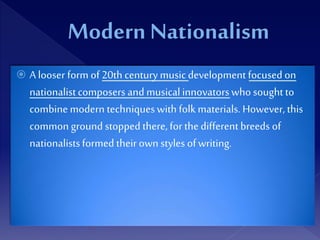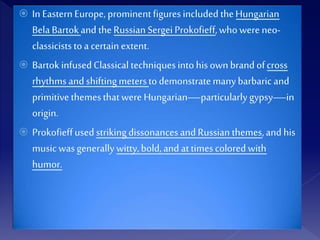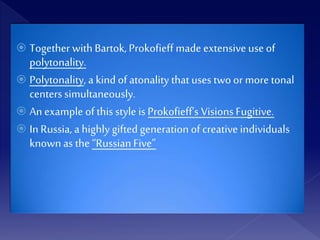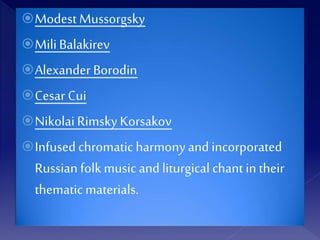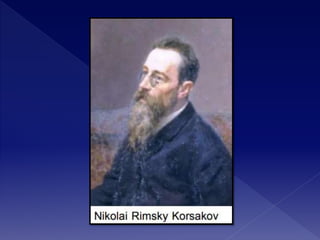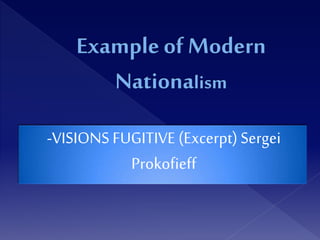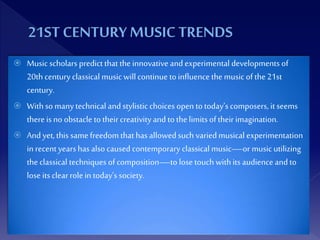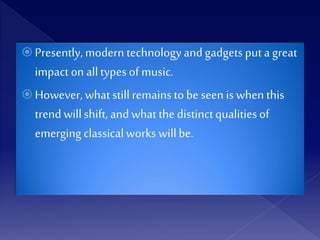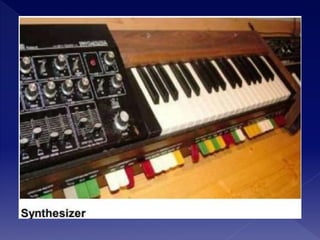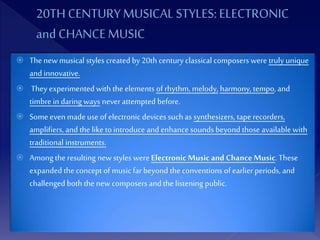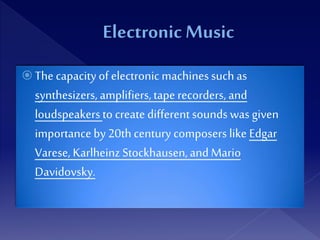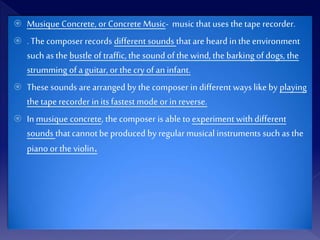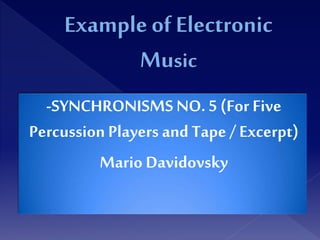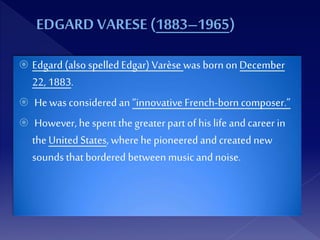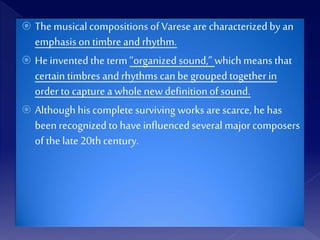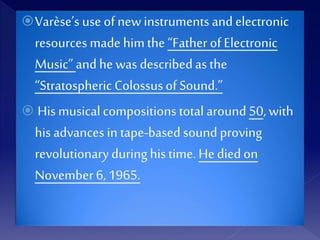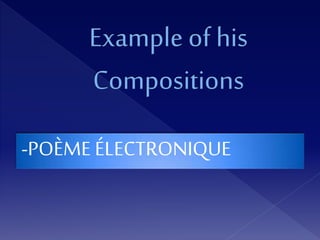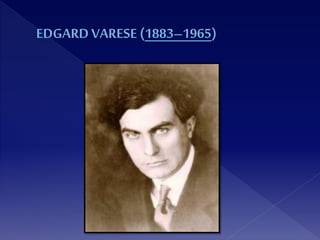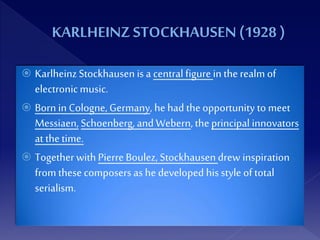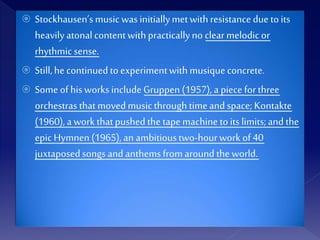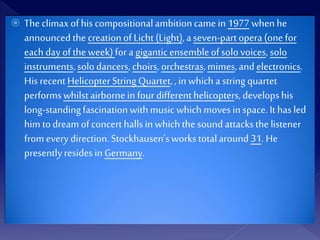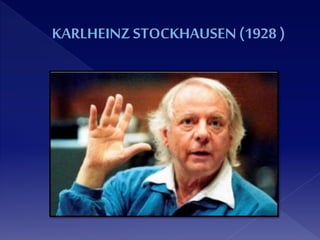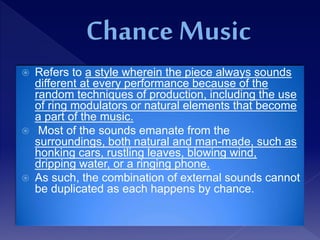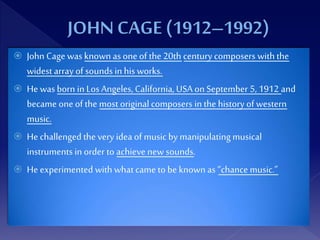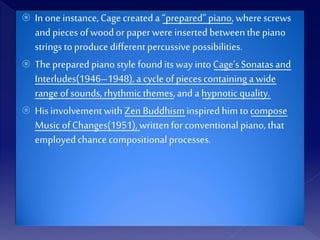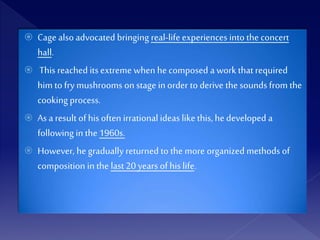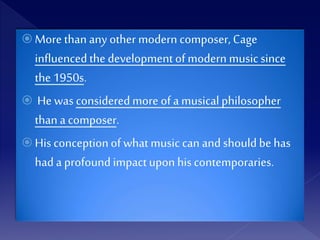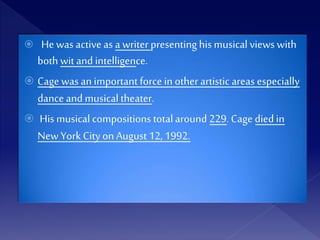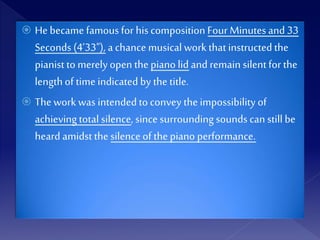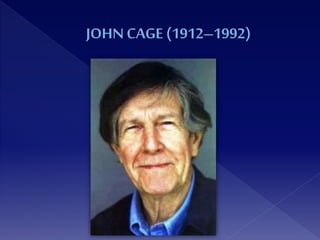MAPEH 10.pptx
- 2. ï A looser form of20th century musicdevelopment focused on nationalistcomposers and musicalinnovatorswho soughtto combine modern techniqueswith folk materials. However, this common ground stopped there, for thedifferentbreeds of nationalistsformed their own styles ofwriting.
- 5. ï In EasternEurope,prominentfiguresincluded theHungarian BelaBartokand theRussian SergeiProkofieff,whowere neo- classiciststo a certain extent. ï Bartok infusedClassical techniquesinto his own brand ofcross rhythms and shiftingmeterstodemonstratemanybarbaric and primitivethemesthatwere Hungarianâparticularlygypsyâin origin. ï Prokofieffusedstrikingdissonances and Russian themes,and his music wasgenerallywitty,bold,and attimescoloredwith humor.
- 6. ï Together with Bartok, Prokofieff made extensiveuseof polytonality. ï Polytonality, a kind of atonality that uses two or more tonal centers simultaneously. ï An example of this style isProkofieffâs Visions Fugitive. ï InRussia, a highly gifted generation of creative individuals knownas theâRussian Fiveâ
- 7. ïModest Mussorgsky ïMiliBalakirev ïAlexander Borodin ïCesar Cui ïNikolaiRimskyKorsakov ïInfused chromatic harmonyand incorporated Russian folkmusic and liturgical chant intheir thematic materials.
- 9. -VISIONS FUGITIVE (Excerpt) Sergei Prokofieff
- 10. ï Music scholars predictthat the innovative and experimental developments of 20thcentury classical music willcontinue toinfluence the music ofthe21st century. ï Withso manytechnical and stylistic choices open totodayâscomposers, itseems there is no obstacle totheircreativityand tothe limitsoftheirimagination. ï And yet,this same freedom that has allowedsuch variedmusical experimentation in recent yearshas also caused contemporary classical musicâor music utilizing the classical techniques ofcompositionâto lose touch withits audience and to lose itsclearrolein todayâs society.
- 11. ï Presently, modern technology andgadgets put a great impact on alltypes of music. ï However, what stillremains tobe seen is when this trend willshift, andwhat the distinctqualitiesof emerging classicalworks willbe.
- 13. ï Thenewmusical styles createdby 20th century classical composers were truly unique and innovative. ï They experimented with the elements of rhythm, melody, harmony, tempo, and timbre in daring ways neverattempted before. ï Someeven madeuse of electronic devices such as synthesizers, tape recorders, amplifiers, and the like to introduce and enhance sounds beyondthose available with traditional instruments. ï Among the resulting newstyles were Electronic Musicand ChanceMusic.These expanded the concept of music far beyond the conventions of earlierperiods, and challenged both the new composers and the listening public.
- 15. ï The capacityof electronicmachinessuch as synthesizers, amplifiers,tape recorders, and loudspeakersto create different sounds was given importanceby 20th century composers like Edgar Varese, Karlheinz Stockhausen,and Mario Davidovsky.
- 16. ï Musique Concrete, or Concrete Music- music that uses the tape recorder. ï . The composer records different sounds that are heard in the environment such as the bustle of traffic, the sound of the wind, the barking of dogs, the strumming of a guitar, or the cry of an infant. ï These sounds are arranged by the composer in different wayslike by playing the tape recorder in its fastest mode or in reverse. ï In musique concrete, the composer is able to experiment with different sounds that cannot be produced by regular musical instruments such as the piano or the violin.
- 17. -SYNCHRONISMS NO. 5 (For Five Percussion Players and Tape / Excerpt) Mario Davidovsky
- 18. ï Edgard (also spelled Edgar) VarĂšse was born on December 22, 1883. ï He was considered an âinnovative French-born composer.â ï However, he spent thegreater part of his life and career in theUnited States, wherehe pioneered and created new sounds thatbordered between music and noise.
- 19. ï The musical compositions of Varese are characterized by an emphasis on timbre and rhythm. ï Heinvented theterm âorganized sound,â whichmeans that certain timbres and rhythms can be grouped togetherin order to capture a whole new definitionof sound. ï Althoughhis complete surviving works are scarce, he has been recognized to have influencedseveral majorcomposers of the late 20th century.
- 20. ïVarĂšseâs use of new instruments and electronic resources made himthe âFather of Electronic Musicâandhe was describedas the âStratospheric Colossus of Sound.â ï His musical compositions total around 50, with his advances in tape-based sound proving revolutionary duringhis time. He diedon November 6,1965.
- 23. ï KarlheinzStockhausen is a central figurein therealm of electronicmusic. ï Born in Cologne, Germany, hehad theopportunity to meet Messiaen,Schoenberg, and Webern, theprincipal innovators at thetime. ï TogetherwithPierre Boulez, Stockhausendrew inspiration from thesecomposers as he developed his style of total serialism.
- 24. ï Stockhausenâsmusic wasinitiallymetwithresistance due toits heavilyatonalcontentwithpracticallyno clear melodicor rhythmic sense. ï Still,he continuedtoexperimentwithmusiqueconcrete. ï Someofhis worksincludeGruppen (1957), a pieceforthree orchestras thatmovedmusicthrough timeand space; Kontakte (1960), aworkthatpushedthe tapemachinetoits limits;and the epicHymnen (1965), an ambitioustwo-hourwork of40 juxtaposedsongs and anthemsfromaround the world.
- 25. ï Theclimaxofhis compositionalambitioncamein 1977when he announced thecreationofLicht(Light),a seven-partopera(one for each day ofthe week)foragiganticensembleofsolovoices,solo instruments,solodancers,choirs, orchestras,mimes,and electronics. His recentHelicopter String Quartet,, inwhich a stringquartet performswhilstairbornein four differenthelicopters,developshis long-standingfascinationwithmusic which movesin space.It has led him todream ofconcert hallsinwhich the sound attacksthe listener fromevery direction.Stockhausenâsworks totalaround 31. He presentlyresidesinGermany.
- 28. ï Refers to a style wherein the piece always sounds different at every performance because of the random techniques of production, including the use of ring modulators or natural elements that become a part of the music. ï Most of the sounds emanate from the surroundings, both natural and man-made, such as honking cars, rustling leaves, blowing wind, dripping water, or a ringing phone. ï As such, the combination of external sounds cannot be duplicated as each happens by chance.
- 29. ï John Cage was known as one of the 20th century composers with the widest array of sounds in his works. ï He wasborn in Los Angeles, California, USA on September 5, 1912 and became one of the most original composers in the history of western music. ï He challenged the very idea of music by manipulatingmusical instruments in order to achieve new sounds. ï He experimented with what came to be known as âchance music.â
- 30. ï In one instance,Cagecreateda âpreparedâpiano, wherescrews and pieces ofwoodor paperwere insertedbetweenthepiano strings toproduce differentpercussive possibilities. ï Thepreparedpianostyle foundits way into CageâsSonatasand Interludes(1946â1948),a cycle of piecescontaininga wide range ofsounds, rhythmic themes,and ahypnoticquality. ï His involvementwithZen Buddhisminspiredhim tocompose Music ofChanges(1951),writtenforconventionalpiano,that employedchance compositionalprocesses.
- 31. ï Cage also advocated bringing real-lifeexperiences into the concert hall. ï This reachedits extreme when he composed a work that required him to fry mushrooms on stage in order to derive the sounds from the cooking process. ï As a result of his often irrational ideas like this, he developed a following in the 1960s. ï However, he gradually returned to the more organized methods of composition in the last20 years of his life.
- 32. ï More than any other modern composer, Cage influencedthe development of modern musicsince the 1950s. ï He was consideredmore of a musicalphilosopher than a composer. ï His conceptionof what music can and shouldbe has had a profoundimpactupon hiscontemporaries.
- 33. ï He was activeas a writer presentinghis musical views with both wit and intelligence. ï Cage was an important force in other artistic areas especially dance and musicaltheater. ï Hismusical compositions totalaround 229. Cage diedin New York City on August 12, 1992.
- 34. ï He became famous for his composition Four Minutes and 33 Seconds (4â33"), a chance musical work thatinstructed the pianist to merelyopen thepiano lid and remain silentfor the lengthof timeindicated by the title. ï Thework was intendedto convey the impossibility of achieving total silence, since surrounding sounds can still be heard amidst the silenceof the piano performance.
- 36. THANK YOU!!!

